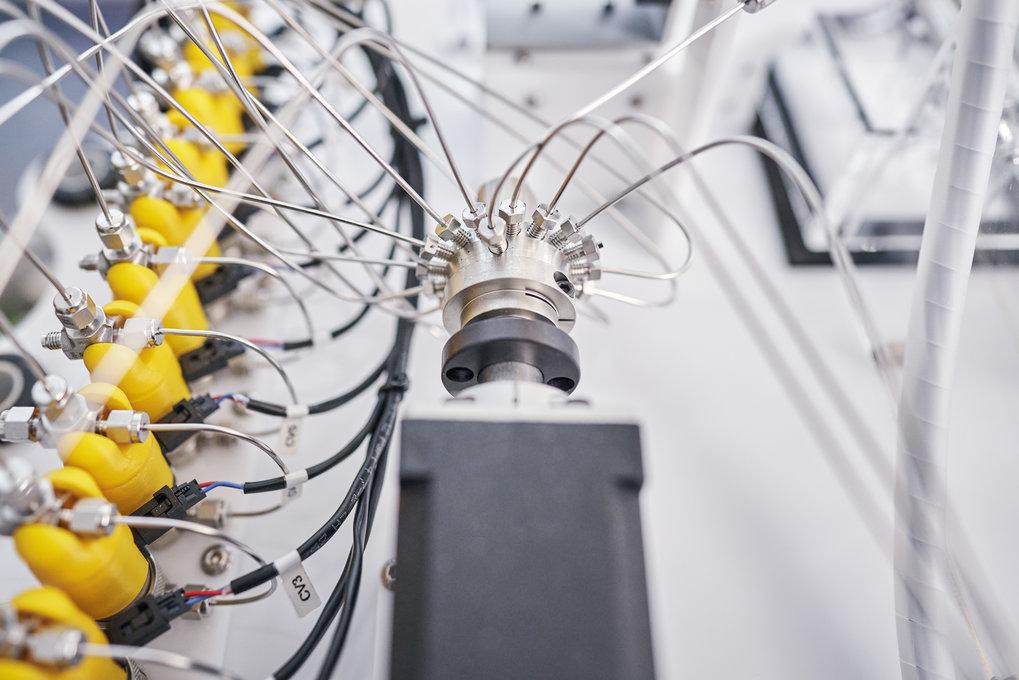
Measurement of the O2/N2 ratio in air

A. Schroll/BGC
Small changes in the oxygen content (O2) of the air provide information about the formation and fate of CO2 in the atmosphere. An increase in CO2 due to oxidation processes is accompanied by a simultaneous decrease in O2 in the air. From the different stoichiometric ratios of these two fluxes for different processes such as fossil fuel combustion or different biogeochemical processes, conclusions can be drawn about their respective quantitative importance. As a result, it is possible to infer what fraction of CO2 produced by fossil carbon combustion remains in the atmosphere, and what fraction dissolves in the ocean or is sequestered in the terrestrial biosphere. The decrease in oxygen is very small relative to the total amount of O2 in the air, but it is measurable. For this purpose, the ratio of oxygen to nitrogen (O2/N2) is measured instead of oxygen concentration, since oxygen concentration is also affected by variations in the concentrations of other components of air (such as CO2). Nitrogen makes up the largest proportion of the air and is only converted into other compounds to a negligible extent.

A. Schroll/BGC
The O2/N2 ratio of sample air collected with special glass containers (flasks) at measuring stations is measured with a mass spectrometer (ThermoFischer deltaV) developed for this type of measurements. Since the manufacturer's specifications of the instrument were not sufficient for our purposes, we developed and automated an extensive measurement periphery ourselves.
The sample air is admitted into the mass spectrometer via a thin capillary. The molecules contained in the air are ionized with the aid of a filament. In an electric field, these charged molecules are accelerated, focused, mass-selected using ion-optical elements, and detected with mass-specific detectors. Mass separation is performed with a strong electromagnet, which separates the ions according to their mass to charge ratio. To achieve the required accuracy, all samples are measured in regular alternation with a reference air sample. All samples as well as reference standards are measured using the same methods under the same conditions.

M. Eritt/BGC
The measured values are given as deviation to a reference standard in the δ notation in unitless perMeg (1perMeg=0.000001), where δ(O2/N2) =((O2/N2)sample-(O2/N2)reference)/ (O2/N2)reference). The global reference is the SIO (Scripps Institution Oceanography) calibration scale, whose primary standard gases are compressed air samples from 1990, which were filled there at the same time as the first measurements of the ongoing O2/N2 time series were made.
The calibration of the O2/N2 measurements in our laboratory is performed by comparison with measurement of standards (air samples with precisely defined compositions). These were measured in the Central Calibration Laboratory at SIO, which is responsible for this parameter worldwide. The agreement of the scales between the measurement networks is regularly checked by interlaboratory comparisons in which the same air samples are measured at different laboratories worldwide. The agreement of the measurements should not exceed the limits defined by the WMO Expert Group in the compatibility goals. For (O2/N2), the goal is that the oxygen to nitrogen ratio data agree with each other to ±2 perMeg = 0.000002. The measurements are very sensitive to a variety of external influences such as temperature and air pressure variations.
The measurement results are provided within ICOS to the Atmospheric Thematic Center in Paris/France and made available to the public via the ICOS Carbon Portal in Lund/Sweden.
Link nội dung: https://pmil.edu.vn/o2-ra-n2-a54578.html